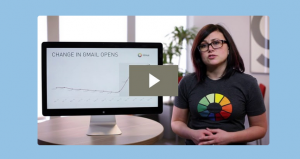
Our website doesn’t reflect who we are as a company.
It doesn’t tell a story.
It’s hard for our customers to find what they need.
It just feels dated.
Sound familiar? We hear these comments often when we first start a website redesign project. A new website is a chance for a clean slate—a chance to resolve longstanding concerns and communicate your value proposition more clearly. It’s a chance to start fresh with a bold new design, a chance to make a great first impression.

And you’re eager to jump in.
It’s easy to get excited about the design elements since they are the most noticeable changes (and an important part of shaping the user experience), but it’s the strategy behind the website that will make it work.
Before you start creating design concepts, there are a few fundamental questions to consider first.
Taking the time to discuss these big-picture considerations with your sales, marketing, customer service and leadership teams will ensure everyone is on the same page before you start creating new pages.
Here are seven essential questions that should be part of that discussion.
What Are the Main Objectives We Want to Achieve?

Consider how your website fits into your sales and marketing goals. If your goal is to grow sales by 10 percent, take a step back and determine how your new website will help you achieve that. Set specific, measurable, realistic and time-sensitive goals that relate back to that, such as growing sales-qualified leads by 10 percent over the next year.
Other goals might include:
- Increasing traffic to specific product pages
- Increasing blog subscribers
- Increasing conversion rates
Once you can articulate what you want your website to accomplish and how you’ll measure success with sales and marketing KPIs, you’ll be able to get a better handle on how your new website should be structured.
Who Are the Primary Visitors?

This might seem like an obvious question until you dive deeper. For one thing, the primary user of your product or service isn’t always the person doing the research on the purchase. You might be selling engine components to a car manufacturer and assume you’re trying to reach design engineers, for instance, but that might not be the case. The design engineer will certainly set the specifications, but he or she might then look to a purchasing manager to research products that fit that criteria.
A design engineer may not care about cost or delivery, while a purchasing manager is primarily concerned with finding the best value and ensuring stability in the supply chain. That purchasing manager is also likely to be influenced by other decision-makers.
Taking the time to research your buyer personas by interviewing current customers, ideal prospects and even a few prospects who didn’t buy can help you to clarify who is most often visiting your website and what they need.
Where Are They Going For Information?

As you talk to buyers, ask them where they typically look for news about their industry. This will help you determine the tone of your website and what channels will be most effective in driving traffic there through demand generation.
Once they arrive at your current website, where are they clicking? Use Google Analytics or the marketing software that hosts your current site to determine which pages have the most visits. HubSpot recently added attribution reports, which allows you to determine not only which pages have the most traffic, but which ones lead to conversions.
These reports take into account all the steps a visitor takes from the time they first land on your website to the time they become a customer, giving you hard numbers to map out their journey. This allows you to pinpoint which website content is most effective in actually driving sales.
What Does The Typical Sales Cycle Entail?

The most beautiful website in the world is just window dressing if it doesn’t move visitors further along in the sales cycle. To do that, your sales and marketing teams need a shared understanding of how potential customers are finding you and what happens next. Your sales team may not be aware of how your marketing efforts are driving visitors and which ones are more successful, while the marketing department doesn’t always know exactly what happens once someone fills out a form.
Chances are, your customers are going to visit your website multiple times before they request a consultation, and they’re going to return throughout the decision-making process.
They’re probably also going to enlist feedback from others on their team and will ultimately need to convince someone at a higher level, whether it’s a department manager, the COO or CEO. They may not visit the website, but your primary buyer might forward them a high-level overview. We call these secondary personas.
Consider what information you’ll need on your website to help both your primary and secondary personas at every stage in the sales process.
What Are The Barriers to Buying?

As you consider the sales cycle, think about the concerns your buyers have along the way. How can you structure your website to address those concerns and ensure you have valuable content on every page?
Ask your customers:
- What can create hesitation or delay a decision?
- What kind of data do they need to see for validation?
Ask your sales team:
- What questions do potential buyers most commonly ask?
- What resources do you find yourself sharing with them most often?
Answering these questions will help you determine what elements you need to help your buyers overcome their concerns and build their confidence in your offerings.
What Are Our Competitors Doing?

When was the last time you typed your own services into a Google search? What names came up, other than your own? If you haven’t done an in-depth analysis of your competitors or if it’s been awhile, you’re likely to be surprised by what you find. Take the time to talk about what appeals to you about your competitors’ websites from a design and content perspective.
How do they position their products or services? How can you position yours to sound more appealing in comparison?
What Messages Are We Eager to Communicate?

A website redesign project is a perfect opportunity to clarify or refresh your value proposition. The message on your homepage banner is essentially the first impression you’ll make to a potential buyer, so give this the time and attention it deserves.
Consider what sets you apart from the competition and what general feelings you want to convey. Yes, you’re selling engine parts (or software, or professional services), but you’re also selling something else. Is it efficiency? Peace of mind? Cost savings? Consider the big-picture goal your solution accomplishes for the buyer and think about the best way to communicate that through your website.
Taking the Next Step
Redesigning your company’s website involves much more than following popular website design trends or using stronger imagery, although those elements have a huge impact on the first impression. To get the most out of your new website, take a holistic approach that starts with a website redesign strategy.
When done well, it’s a massive undertaking.
If you don’t have an in-house team who can dedicate their efforts to conducting research, developing a strategy and executing the content, design and technical aspects involved, consider enlisting the help of an agency that specializes in website redesign for inbound marketing.
Our team can guide yours through the process and make it more manageable. For more on how to get the most out of your website redesign, check out this guide:
(185)







